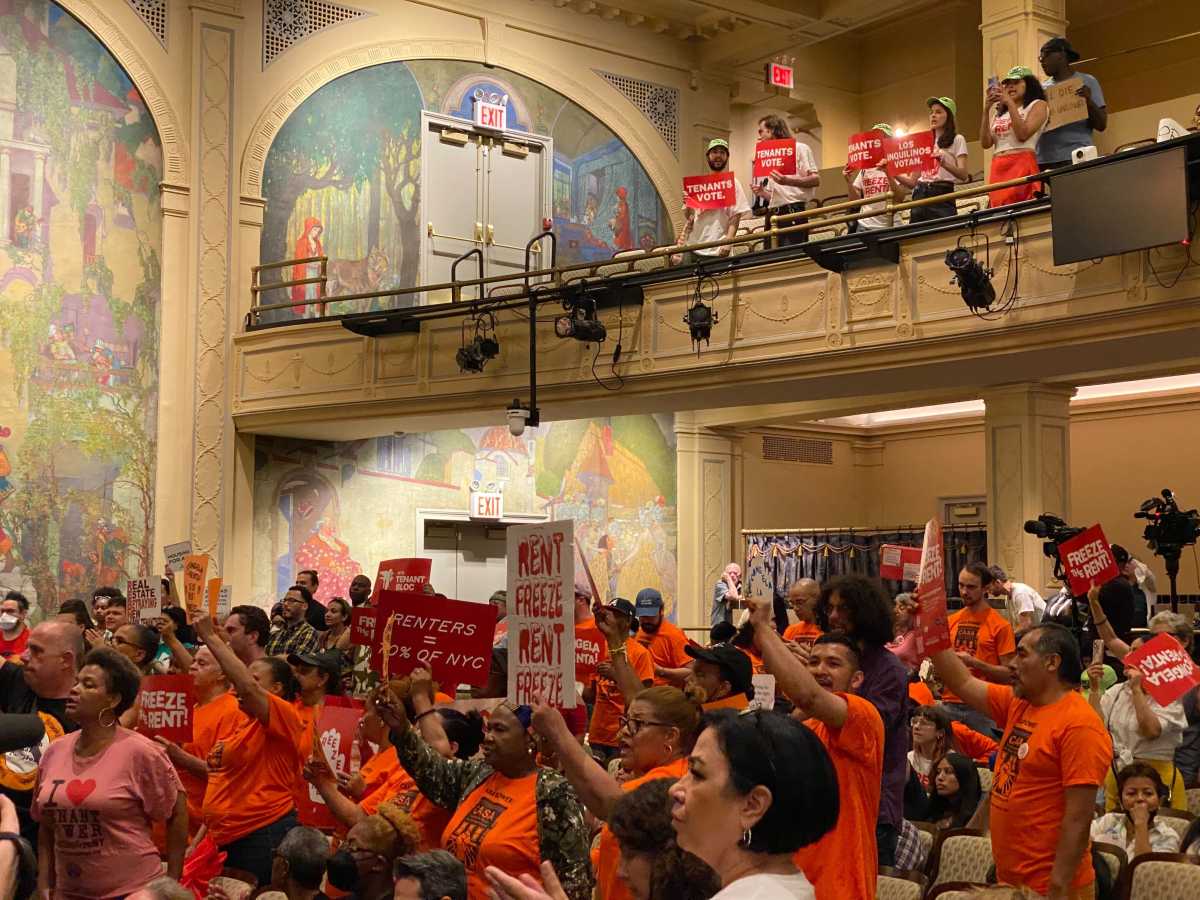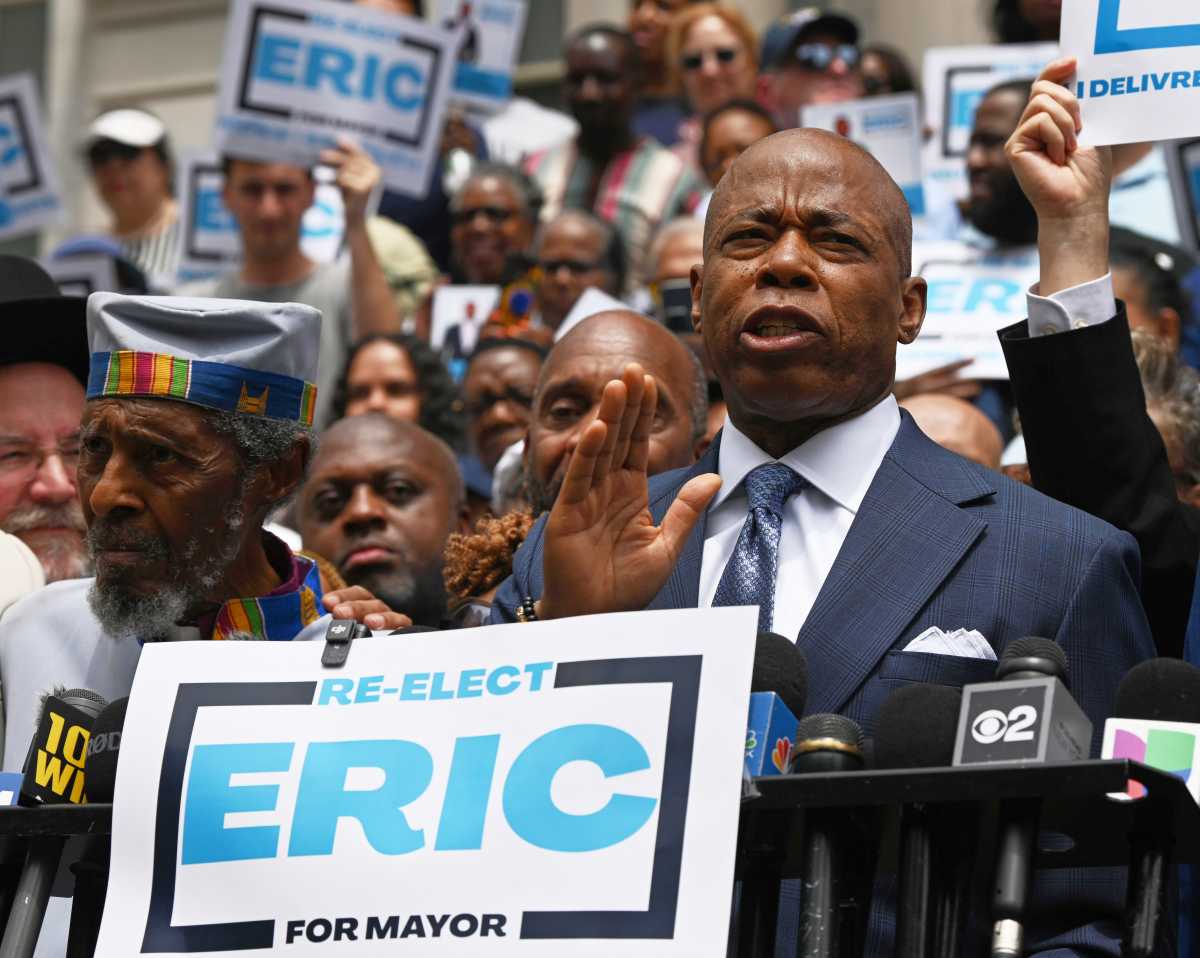The U.S. Supreme Court struggled on Tuesday to balance the rights of property
owners against the goals of town officials who want to sweep away old
neighborhoods and turn the land over to private developers.
Riverfront residents who are suing the town of New London, Conn., say
their working-class neighborhood is slated for destruction under the governmental
authority of eminent domain, primarily to build an office complex that
will benefit a pharmaceutical company that built its research and development
headquarters nearby.
The outcome of the case could significantly affect Brooklyn homeowners
who live in buildings within the footprint of developer Bruce Ratner’s
proposed arena to house his New Jersey Nets basketball team in Prospect
Heights.
That plan, known as Atlantic Yards, also relies on the state’s power
of eminent domain, to condemn nearly 11 acres of private property for
Ratner’s six-square-block development, which also includes 17 commercial
and residential high-rises on property emanating from the intersection
of Atlantic and Flatbush avenues.
Several representatives from the Prospect Heights neighborhood traveled
to Washington, D.C., Tuesday to hear the arguments in the New London case.
Sitting in the courtroom were Councilwoman Letitia James, who represents
Prospect Heights, Fort Greene and Clinton Hill; civil rights lawyer Norman
Siegel, who has been retained to represent Prospect Heights residents
in a potential lawsuit against the Ratner plan; and a legal volunteer
for the anti-arena group Develop — Don’t Destroy Brooklyn, which
maintains that the proposed 19,000-seat arena, as well as the up to 5,800
units of housing planned by Ratner are a far cry from the legitimate public
use for which eminent domain is typically called into play.
An attorney representing the City of New London, Wesley Horton, told the
high court justices on Tuesday that the revitalization project will create
new jobs and trigger much-needed economic growth. He argued that increased
tax revenue is enough of a legal basis for the city to invoke eminent
domain and compel the residents to sell their homes.
If a city wanted to seize property in order to turn a “Motel 6 into
a Ritz-Carlton, that would be OK?” asked Justice Sandra Day O’Connor.
“Yes, your honor, it would be,” Horton replied.
James said she had high hopes for the outcome of the Connecticut case,
based on the questions raised by the justices.
“[O’Connor] really hit the nail right on the head, when she
described how one revenue-generating entity can replace another,”
said the councilwoman. “It’s a complete expansion of the public
use clause laid out in our Constitution.”
The justices expressed sympathy for the longtime residents of the Fort
Trumbull section of New London. At the same time, they questioned whether
the court has the authority to stop the town’s plans.
The outcome could have significant implications nationwide.
In recent years, there have been more than 10,000 instances of private
property being threatened with condemnation or actually condemned by government
for private use, according to the Institute for Justice. The group represents
the New London residents who filed the case.
Scott Bullock, representing the neighborhood residents, argued that government
cannot take private property from one owner and provide it to another
just because the new commercial project will boost the city’s finances.
The city plans to give the developers a 99-year lease for a dollar a year.
“More than tax revenue was at stake,” Justice Ruth Bader Ginsburg
replied. “The town had gone down and down” economically.
O’Connor questioned whether the homeowners were asking the court
to “second-guess” the governmental power of eminent domain.
The legal arguments concern the Fifth Amendment prohibition against taking
private property for public use without just compensation.
The City of New London says it is willing to pay a fair price.
“You are paying for it, but you are taking it from somebody who doesn’t
want to sell,” Justice Antonin Scalia told Horton.
Several justices focused on the residents’ argument that the court
should impose standards for governments to meet when they want to sweep
away neighborhoods for economic revitalization.
“A lot of times governments have no clue what they’re going
to do with the property,” Dana Berliner, co-counsel for the residents,
said after the court arguments ended.
New London, a town of less than 26,000, once was a center of the whaling
industry and later became a manufacturing hub. The revitalization project
is a few miles downriver from the U.S. Navy’s submarine base in Groton.
Likewise, Prospect Heights, with a population of roughly 29,000, at one
time featured many factories on the site where the arena and housing complex
is proposed.
With many of those same buildings now vacant or demolished, Forest City
Ratner promises their new residential, office and retail complex to bring
in 10,000 new jobs during the construction phases and activity to help
stimulate what they have called a “blighted” area, a third of
which is occupied by Metropolitan Transportation Authority rail yards
over which the developer would like to build.
The MTA would be paid a fee for use of the air rights over the yards.
The starting point for Tuesday’s arguments was a Supreme Court ruling
five decades ago that allowed governments to take private property for
urban renewal.
The neighborhood’s lawyer, Bullock, seized on that case, contending
there is a difference between the urban blight of 1954 and the current
circumstance of an economically depressed town.
Justice Anthony Kennedy questioned Bullock’s position, saying that
economically depressed areas can quickly become blighted areas.
Ginsburg also wondered whether the urban renewal case offers much hope
for the neighborhood. She pointed out that the issue in that case involved
a department store that was not contributing at all to the blight in the
area.
The court nonetheless cleared the way for local government to take the
department store’s property for the renewal project.
But Councilwoman James said she was most encouraged by the line of question
coming from Justice Scalia.
“Justice [Antonin] Scalia really laid into them,” she said,
when questioning the respondent on public use.
Scalia asked Horton, “So if B pays more than A, that’s acceptable?”
in the case of giving one privately owned property to another private
owner, to which Horton replied, “Yes.”
“They fired tough questions both at the plaintiff as well as the
respondent,” said James. “Based on the questions asked, I was
encouraged. The justices, as well as the respondents, are concerned about
the status of eminent domain.”
New London attorney Daniel Krisch said he was secure in the city’s
argument.
“It went very, very well,” he said. “The court, as they
always do, asked a lot of incisive questions but the court recognized
— at least the questions suggested that they recognized — that
they couldn’t endorse the homeowners’ position without overruling
100 years of their own precedent, and that’s not something they’re
going to do.” But Bullock, the homeowners’ lawyer, said, “Almost
all of the justices seemed troubled by what was going on, and how cities
seem to be pushing the envelope of eminent domain.
“That was one sentiment of the court that we found to be encouraging.”
Chief Justice William Rehnquist, who is battling thyroid cancer, did not
attend the arguments and will be absent for the next two weeks. He has
not attended arguments since October. Justice John Paul Stevens was out
of town and missed the day’s arguments.
Daniel Goldstein, a spokesman for Develop-Don’t Destroy Brooklyn
and a homeowner living within the footprint of the Prospect Heights arena
— by legal terms, the only “holdout” in his Pacific Street
condominium who has not sold or agreed to sell his apartment to Ratner
— said it was hard to tell which way the court would go.
“They’re even more difficult to read at both sides because two
of the justices weren’t there,” Goldstein said, “but it
seems like they’re going to look at the issue of economic development
very closely.
“They may not say economic development is not a public use, but they
will write a decision that will put more of an onus on cities and developers
to prove that their proposed development is economic development.”
“We’re excited to hear what they’ll say come June,”
he added.
Siegel, the former head of the New York Civil Liberties Union, said that
whatever happens, he’s sure clearer language of the constitutional
clause demanding “public use” for eminent domain will be written.
Said Siegel, “I’m cautiously optimistic that the property owners
in the New London case will prevail, and if they prevail the property
owners in Prospect Heights potentially can prevail.”
— with Associated Press reports
























